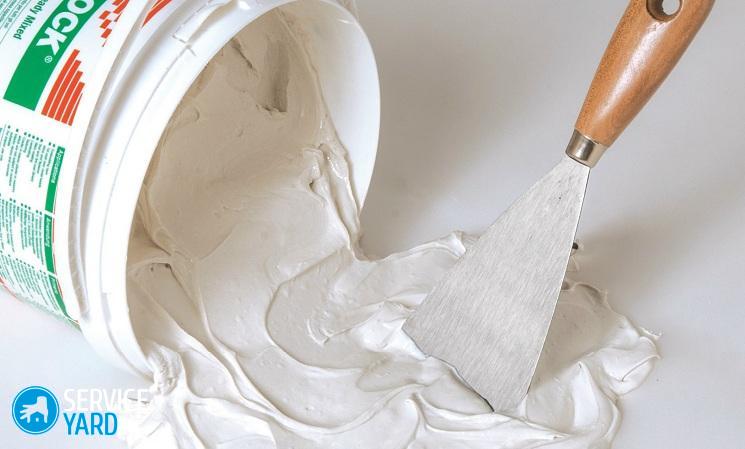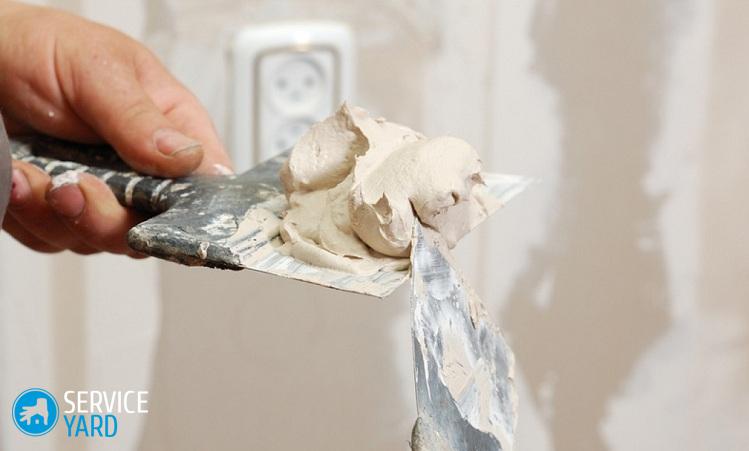What is putty for?

Finishing work is one of the final stages of repair or construction, namely wallpapering, painting walls and ceilings. But for the interior of the room to please the eye, you need a high-quality finish. To do this, putty is applied to the prepared ceiling and walls - a special composition of a paste-like consistency. In more detail, what is putty for, what are its types, how to apply it correctly - we will describe in the article below.
to contents ↑Putty walls
Puttying the walls is a time-consuming and complicated process, which consists in alternately thoroughly applying each layer and their subsequent grinding.
Why putty? It is necessary to provide a perfectly even base on which the finishing materials will be applied - paint, wallpaper or decorative plaster. The final result of your repair will depend on the quality of the putty used. Without a flat surface, you will not get beautifully painted walls or smooth wallpapers.
to contents ↑How much do you really need putty?
Many people ask themselves the question: what is putty for? After all, the plaster is also quite even and can serve as the basis for applying finishing materials. The answer is very simple: the composition of mixtures and mortars for plaster consists of large particles. The plastered surface is rough, the wall can only be rubbed to a more or less acceptable condition. Such surfaces may be suitable for some types of wallpaper. But it will not be suitable for painting - anyway, no matter how carefully you wipe it, flaws will be visible. Also, thin wallpaper will look very ugly.
Important! As for wallpaper, there is one more nuance: under thin coatings, brick, concrete or other base material can shine through, especially if there are remnants of previous materials on the surface. The logical conclusion, why putty is needed, suggests itself - to make the surface homogeneous, one light shade. On a wall prepared using this mixture, you can glue wallpapers of any quality.
Putty consists of the smallest particles - this makes it possible to apply it with a very thin layer on the walls. At the beginning, a layer of starting putty is applied to the plastered surface, where holes and large depressions must be repaired. The layer thickness can be from a couple of millimeters to one and a half centimeters. Sometimes it is necessary to apply 2-3 layers.
to contents ↑Important! Allow the previous coat to dry completely before applying the next.
Putty preparation
Putty surfaces first of all requires careful preparation of the base. The wall should dry completely after plastering.
to contents ↑Important! Do not dry the plaster with fan heaters, as this will cause peeling and cracking.
Types of putties
We described why putty walls. Let's see what types of putties are, because the final result will depend on its quality.
All types of putty are divided into two criteria:
- By degree of readiness.
- By astringent.
Types of putties by degree of readiness:
- Finished.
- Dry.
Types of putty on a binder:
- Gypsum.
- Cement
- Oil-glue.
- Polymer.
According to the method of application:
- Starting.
- Finishing.
Consider each view in more detail.
Start and finish
Starting putty is sold in any hardware store, with its help all major base defects are hidden.
Then putty putty with a metal spatula up to 2 mm thick is applied. It makes it possible to remove all minor flaws. At the same time, the wall is polished after applying each layer, which makes it possible to smooth out all the shortcomings as much as possible. You can apply more layers, until the surface becomes perfectly smooth.
Important! Finishing putty will not hide hollows and cracks that were not patched in the previous step. Be careful and correct all irregularities in advance.
Dry mixes
Used for leveling surfaces, sold in bags or bags of various sizes.
Benefits:
- Easy to cook.
- The ability to prepare any mixture consistency.
- Long stored.
- They are inexpensive.
Disadvantages:
- It takes time to prepare the mixture.
- The period of use of the finished mixture is limited.
Ready
It is made on the basis of modern latexes and dispersions. They are sold in buckets or banks of various sizes and are ready for use.
Benefits:
- Ready to use mixture.
- Use time is limited only by the expiration date.
Disadvantages:
- Higher price compared to dry mixes.
Gypsum plaster
Most often used for leveling surfaces with large differences. They do not have shrinkage, can be applied with a layer of more than 2 mm.
Cement
The advantages include moisture resistance. They can be used in the bathroom and in the kitchen.
The disadvantages are:
- The possibility of small cracks.
- Shrinkage on drying.
- Low elasticity due to cement composition.
Oil-glue
This is the oldest type of putty. They are used for repairs with a minimal budget, where cost is important, not quality of work.
Polymer
The quality of the surface they puttied is very high. Disadvantages are the high cost and the ability to purchase low-quality products.
to contents ↑Stock footage
So we answered the question of interest to many, why do we need putty on the walls. The answer is very simple - it acts as a link between the rough and finish walls, without it you will not achieve the result that will please you after the completion of repair work. Puttying the walls should be carried out only after complete cleaning of the surface from old finishing materials.
- How to choose a vacuum cleaner taking into account the characteristics of the house and coatings?
- What to look for when choosing a water delivery
- How to quickly create comfort at home - tips for housewives
- How to choose the perfect TV - useful tips
- What to look for when choosing blinds
- What should be running shoes?
- What useful things can you buy in a hardware store
- Iphone 11 pro max review
- Than iPhone is better than Android smartphones





